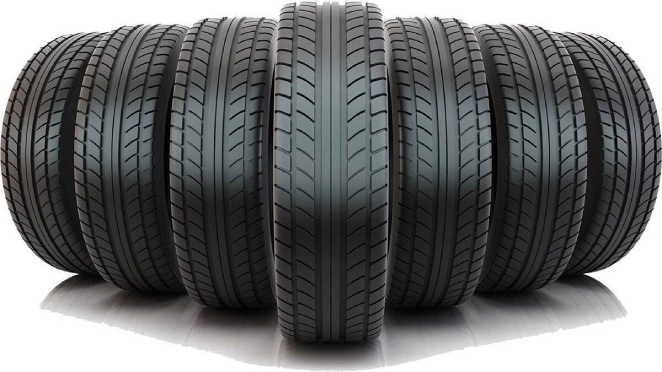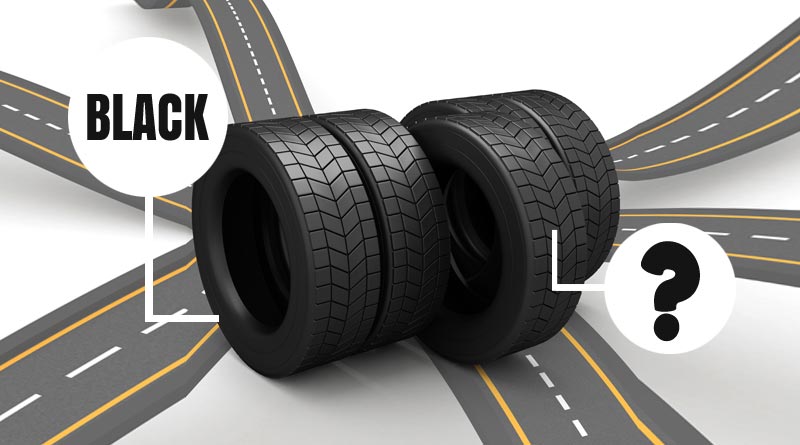Why is the color of a tyre black?
Have you ever wondered why tyres are always black in color? It’s a question that has crossed the minds of many people. While we see a variety of colors in our surroundings, tyres predominantly come in shades of black. But have you ever stopped to think about the reasons behind this? In this blog, we will explore the world of tyre manufacturing and uncover the secrets behind their black color
The Composition of Rubber: Exploring the Ingredients

The composition of rubber used in tyres is a complex blend of various materials that contribute to its durability, flexibility, and performance. Let’s explore the key components that make up the rubber composition:
- Natural Rubber: Derived from the sap of rubber trees, natural rubber forms the base of tyre rubber. It provides elasticity and resilience, allowing the tyre to absorb shocks and maintain shape.
- Synthetic Rubber: Synthetic rubber is created through chemical processes and is often combined with natural rubber. Different types of synthetic rubber, such as styrene-butadiene rubber (SBR) and polybutadiene rubber (BR), are used to enhance specific properties like traction, grip, and wear resistance.
- Fillers: Fillers are added to improve the strength and durability of the rubber. One crucial filler used in tyre production is carbon black.
- Chemical Additives: Various chemical additives are incorporated into the rubber compound to enhance specific characteristics. These additives can include antioxidants, accelerators, curing agents, and plasticizers.
Carbon Black: The Key Ingredient for Black Tyres
Carbon black is the key ingredient that gives tyres their iconic black color. It is a finely divided form of carbon that is added to the rubber compound during tyre manufacturing. Let’s understand into the significance of carbon black and why it is crucial for the production of black tyres:
- Reinforcing Agent: Carbon black acts as a reinforcing filler in the rubber compound. It enhances the strength, durability, and overall performance of the tyre. When mixed with rubber, carbon black forms a network of interconnected structures that reinforce the rubber matrix, making it more resistant to wear, tearing, and abrasion.
- Heat Dissipation: Carbon black has excellent thermal conductivity properties. It helps dissipate heat generated during tyre rolling and braking. By conducting heat away from the tyre’s surface, carbon black aids in preventing overheating, which can lead to tyre degradation and reduced performance.
- UV Protection: Carbon black also provides protection against ultraviolet (UV) radiation from the sun. UV rays can cause the rubber to degrade over time, leading to cracking and deterioration. Carbon black absorbs and disperses UV radiation, acting as a barrier that helps preserve the tyre’s integrity and lifespan.
- Traction and Grip: The addition of carbon black enhances the tyre’s traction and grip on the road. It improves the tyre’s ability to adhere to different surfaces, ensuring better control and stability while driving. This is particularly important for wet and slippery conditions, where maintaining traction is crucial for safety.
- Aesthetic Appeal: While the functional benefits of carbon black are significant, it also plays a role in the aesthetic appeal of tyres. The black color gives tyres a sleek, uniform appearance that is universally associated with tyre aesthetics.
The Functional Benefits of Black Tyres

Black tyres offer several functional benefits, including:
- Traction: The black color of tyres is primarily due to the carbon black used in their manufacturing process. Carbon black improves the traction of the tyre by increasing its grip on the road surface. This is especially important for maintaining control and stability, particularly in wet or slippery conditions. The darker color allows the tyre to better interact with the road and provides better overall traction.
- Heat Dissipation: Black tyres have the ability to dissipate heat effectively. When a vehicle is in motion, the friction between the tyre and the road generates heat. The black color helps in absorbing and radiating this heat, preventing the tyre from overheating. Proper heat dissipation is crucial for tyre longevity and performance.
- UV Resistance: Black tyres are typically designed to resist damage from ultraviolet (UV) radiation. The carbon black in the tyre compound acts as a protective barrier against UV rays, preventing them from deteriorating the tyre’s structure and compromising its integrity. UV resistance helps maintain the tyre’s strength and durability over time.
- Durability: Black tyres are often made from robust materials and designed to withstand various road conditions. The dark coloration helps to conceal minor scuffs, scratches, and dirt, making the tyre’s appearance less affected by external wear and tear. Additionally, the materials used in black tyres are selected for their durability, allowing them to endure challenging environments and prolonging their lifespan.
- Visibility: While black tyres may not have a direct impact on visibility, they provide a visual contrast against lighter surfaces. This contrast can help improve the visibility of moving vehicles, especially in low-light conditions or when there is a lack of clear road markings. The dark color of the tyres makes it easier for other drivers and pedestrians to notice the presence and movement of a vehicle.
How to maintain the black color of the tyres?
To maintain the black color of your tyres, you can follow these tips:
- Regular Cleaning: Clean your tyres regularly to remove dirt, grime, and brake dust that can accumulate on the surface. Use a mild soap or specialized tyre cleaner along with a soft brush or sponge to scrub the tyres gently. Avoid using harsh chemicals or abrasive cleaners that can damage the tyre’s surface.
- Avoid Petroleum-Based Products: Avoid using petroleum-based dressings or tyre shines on your tyres. While these products may initially enhance the shine, they can actually cause the rubber to deteriorate over time and result in a brownish discoloration. Instead, opt for water-based tyre dressings that are specifically formulated for tyre protection and shine.
- Protect from UV Exposure: Extended exposure to sunlight and UV rays can cause the tyres to fade and lose their black color over time. Whenever possible, park your vehicle in shaded areas or use car covers to shield the tyres from direct sunlight. Additionally, consider applying a UV protectant specifically designed for tyres to minimize UV damage.
- tyre Dressing: Applying a tyre dressing can help protect the rubber and maintain the black color. Choose a water-based tyre dressing that contains UV inhibitors to provide a layer of protection against UV rays. Follow the instructions on the product and apply it evenly onto the sidewalls of the tyres using a foam applicator or sponge. Avoid getting the dressing on the tread area to maintain traction.
- Avoid Harsh Cleaning Agents: When washing your vehicle, avoid using harsh chemicals or solvents that can damage the tyres. These substances can cause the rubber to deteriorate or discolor. Stick to mild soaps or specialized tyre cleaners that are safe for use on rubber surfaces.
- Regular Inspection: Periodically inspect your tyres for any signs of damage, such as cuts, bulges, or uneven wear. Damaged tyres can affect their performance and appearance. If you notice any issues, have them inspected by a professional and replace them if necessary.
So, when you see the black tyres on your vehicle, remember that their color is not just an aesthetic choice, but a result of careful engineering to optimize performance, durability, and safety on the road. Like this post? Don’t forget to check out our other short stories in our Quick Reads section.



